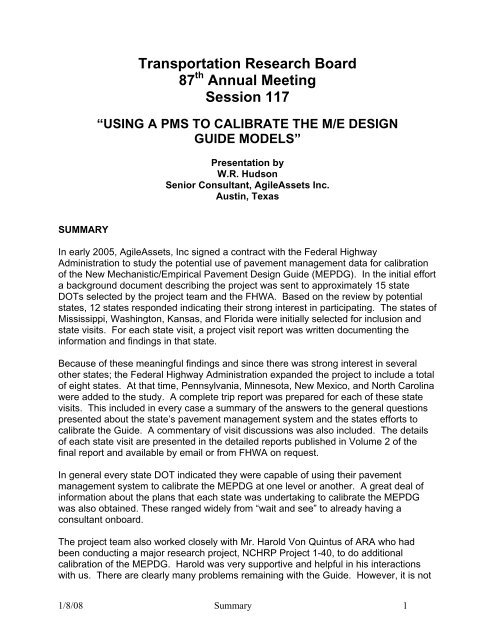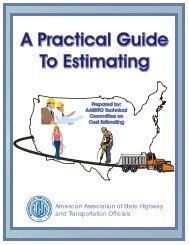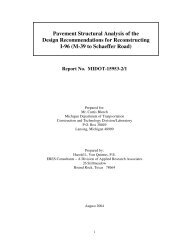Summary of AgileAssets findings on potential use of PMS for ...
Summary of AgileAssets findings on potential use of PMS for ...
Summary of AgileAssets findings on potential use of PMS for ...
You also want an ePaper? Increase the reach of your titles
YUMPU automatically turns print PDFs into web optimized ePapers that Google loves.
SUMMARY<br />
Transportati<strong>on</strong> Research Board<br />
87 th Annual Meeting<br />
Sessi<strong>on</strong> 117<br />
“USING A <strong>PMS</strong> TO CALIBRATE THE M/E DESIGN<br />
GUIDE MODELS”<br />
Presentati<strong>on</strong> by<br />
W.R. Huds<strong>on</strong><br />
Senior C<strong>on</strong>sultant, <str<strong>on</strong>g>AgileAssets</str<strong>on</strong>g> Inc.<br />
Austin, Texas<br />
In early 2005, <str<strong>on</strong>g>AgileAssets</str<strong>on</strong>g>, Inc signed a c<strong>on</strong>tract with the Federal Highway<br />
Administrati<strong>on</strong> to study the <strong>potential</strong> <strong>use</strong> <str<strong>on</strong>g>of</str<strong>on</strong>g> pavement management data <strong>for</strong> calibrati<strong>on</strong><br />
<str<strong>on</strong>g>of</str<strong>on</strong>g> the New Mechanistic/Empirical Pavement Design Guide (MEPDG). In the initial ef<strong>for</strong>t<br />
a background document describing the project was sent to approximately 15 state<br />
DOTs selected by the project team and the FHWA. Based <strong>on</strong> the review by <strong>potential</strong><br />
states, 12 states resp<strong>on</strong>ded indicating their str<strong>on</strong>g interest in participating. The states <str<strong>on</strong>g>of</str<strong>on</strong>g><br />
Mississippi, Washingt<strong>on</strong>, Kansas, and Florida were initially selected <strong>for</strong> inclusi<strong>on</strong> and<br />
state visits. For each state visit, a project visit report was written documenting the<br />
in<strong>for</strong>mati<strong>on</strong> and <str<strong>on</strong>g>findings</str<strong>on</strong>g> in that state.<br />
Beca<strong>use</strong> <str<strong>on</strong>g>of</str<strong>on</strong>g> these meaningful <str<strong>on</strong>g>findings</str<strong>on</strong>g> and since there was str<strong>on</strong>g interest in several<br />
other states; the Federal Highway Administrati<strong>on</strong> expanded the project to include a total<br />
<str<strong>on</strong>g>of</str<strong>on</strong>g> eight states. At that time, Pennsylvania, Minnesota, New Mexico, and North Carolina<br />
were added to the study. A complete trip report was prepared <strong>for</strong> each <str<strong>on</strong>g>of</str<strong>on</strong>g> these state<br />
visits. This included in every case a summary <str<strong>on</strong>g>of</str<strong>on</strong>g> the answers to the general questi<strong>on</strong>s<br />
presented about the state’s pavement management system and the states ef<strong>for</strong>ts to<br />
calibrate the Guide. A commentary <str<strong>on</strong>g>of</str<strong>on</strong>g> visit discussi<strong>on</strong>s was also included. The details<br />
<str<strong>on</strong>g>of</str<strong>on</strong>g> each state visit are presented in the detailed reports published in Volume 2 <str<strong>on</strong>g>of</str<strong>on</strong>g> the<br />
final report and available by email or from FHWA <strong>on</strong> request.<br />
In general every state DOT indicated they were capable <str<strong>on</strong>g>of</str<strong>on</strong>g> using their pavement<br />
management system to calibrate the MEPDG at <strong>on</strong>e level or another. A great deal <str<strong>on</strong>g>of</str<strong>on</strong>g><br />
in<strong>for</strong>mati<strong>on</strong> about the plans that each state was undertaking to calibrate the MEPDG<br />
was also obtained. These ranged widely from “wait and see” to already having a<br />
c<strong>on</strong>sultant <strong>on</strong>board.<br />
The project team also worked closely with Mr. Harold V<strong>on</strong> Quintus <str<strong>on</strong>g>of</str<strong>on</strong>g> ARA who had<br />
been c<strong>on</strong>ducting a major research project, NCHRP Project 1-40, to do additi<strong>on</strong>al<br />
calibrati<strong>on</strong> <str<strong>on</strong>g>of</str<strong>on</strong>g> the MEPDG. Harold was very supportive and helpful in his interacti<strong>on</strong>s<br />
with us. There are clearly many problems remaining with the Guide. However, it is not<br />
1/8/08 <str<strong>on</strong>g>Summary</str<strong>on</strong>g> 1
the purpose <str<strong>on</strong>g>of</str<strong>on</strong>g> this project to evaluate the MEPDG itself but to deal with the calibrati<strong>on</strong><br />
<str<strong>on</strong>g>of</str<strong>on</strong>g> the MEPDG using l<strong>on</strong>g-term pavement management data. The fact that the MEPDG<br />
has problems is menti<strong>on</strong>ed, beca<strong>use</strong> this has major impact <strong>on</strong> the ef<strong>for</strong>ts and attitudes<br />
<str<strong>on</strong>g>of</str<strong>on</strong>g> the states and has thus impacted this project.<br />
As part <str<strong>on</strong>g>of</str<strong>on</strong>g> the project there was an opportunity to interact with the FHWA DGIT (Design<br />
Guide Implementati<strong>on</strong> Team). The project team attended a DGIT Traffic Workshop in<br />
Biloxi, Mississippi in May 3-4, 2005, and also participated in a web cast workshop in<br />
C<strong>on</strong>necticut with the title “Material Inputs <strong>for</strong> M-E Pavement Design” carried out by<br />
DGIT <strong>on</strong> March 30-31, 2005. More recently the project team presented the main results<br />
<str<strong>on</strong>g>of</str<strong>on</strong>g> this study during a web cast workshop in C<strong>on</strong>necticut <strong>on</strong> September 20, 2006 with<br />
the title “Use <str<strong>on</strong>g>of</str<strong>on</strong>g> <strong>PMS</strong> Data to Calibrate the new MEPDG”. Together these workshops<br />
were helpful in understanding more about what DGIT and FHWA are doing to help the<br />
states implement the MEPDG.<br />
Prior to visiting the states a series <str<strong>on</strong>g>of</str<strong>on</strong>g> questi<strong>on</strong>s and requirements <strong>for</strong> each state to<br />
participate in the study were <strong>for</strong>mulated. A resp<strong>on</strong>se was requested, including a<br />
detailed write up <str<strong>on</strong>g>of</str<strong>on</strong>g> their active pavement management system be provided prior to our<br />
visits. Two states had undertaken major research projects but have slowed down or<br />
stopped these projects pending receipt <str<strong>on</strong>g>of</str<strong>on</strong>g> an improved versi<strong>on</strong> <str<strong>on</strong>g>of</str<strong>on</strong>g> the MEPDG.<br />
The in<strong>for</strong>mati<strong>on</strong> obtained <strong>for</strong> eight state DOTs was quite detailed. In order to compare<br />
this in<strong>for</strong>mati<strong>on</strong> and c<strong>on</strong>solidate the <str<strong>on</strong>g>findings</str<strong>on</strong>g>, a Matrix was defined <strong>for</strong> data elements<br />
required to <strong>use</strong> or calibrate the MEPDG. In this matrix the in<strong>for</strong>mati<strong>on</strong> from all <str<strong>on</strong>g>of</str<strong>on</strong>g> the<br />
states visited was tabulated. While this is <str<strong>on</strong>g>of</str<strong>on</strong>g> necessity a summary <str<strong>on</strong>g>of</str<strong>on</strong>g> the details found, it<br />
provides an excellent method <strong>for</strong> comparing <str<strong>on</strong>g>findings</str<strong>on</strong>g> am<strong>on</strong>g the eight states visited.<br />
The <str<strong>on</strong>g>findings</str<strong>on</strong>g> in that Matrix are also summarized in Chapter 3, column by column.<br />
Careful study <str<strong>on</strong>g>of</str<strong>on</strong>g> the Matrix results will provide the reader with a great deal <str<strong>on</strong>g>of</str<strong>on</strong>g> detail<br />
about each state and a meaningful comparis<strong>on</strong> am<strong>on</strong>g the states. The summaries<br />
serve well to synthesize the overall <str<strong>on</strong>g>findings</str<strong>on</strong>g> <str<strong>on</strong>g>of</str<strong>on</strong>g> the project and provide the state DOTs a<br />
way to compare their own activities.<br />
Shell Oil Company introduced the world’s first mechanistic pavement design in the<br />
1970’s. A descripti<strong>on</strong> <str<strong>on</strong>g>of</str<strong>on</strong>g> that method and a discussi<strong>on</strong> <str<strong>on</strong>g>of</str<strong>on</strong>g> its history and calibrati<strong>on</strong> are<br />
included in the final report. This history <str<strong>on</strong>g>of</str<strong>on</strong>g> the Shell Method provides good background<br />
in<strong>for</strong>mati<strong>on</strong> <strong>for</strong> state implementati<strong>on</strong> and calibrati<strong>on</strong>.<br />
The <str<strong>on</strong>g>findings</str<strong>on</strong>g> <str<strong>on</strong>g>of</str<strong>on</strong>g> the project are promising. There were differences am<strong>on</strong>g the states<br />
visited as would be expected am<strong>on</strong>g eight states from a variety <str<strong>on</strong>g>of</str<strong>on</strong>g> locati<strong>on</strong>s and sizes<br />
across the United States. Nevertheless, there is a general c<strong>on</strong>sensus that all eight <str<strong>on</strong>g>of</str<strong>on</strong>g><br />
these states could undertake a pavement management calibrati<strong>on</strong> <str<strong>on</strong>g>of</str<strong>on</strong>g> the MEPDG and it<br />
seems likely that many other states could do the same. Clearly, additi<strong>on</strong>al work is<br />
needed and there are a number <str<strong>on</strong>g>of</str<strong>on</strong>g> problems to be resolved. Nevertheless, there are<br />
many benefits that can accrue to a state DOT by undertaking the <strong>use</strong> <str<strong>on</strong>g>of</str<strong>on</strong>g> its pavement<br />
management system to calibrate the MEPDG. Not the least <str<strong>on</strong>g>of</str<strong>on</strong>g> these is the fact that this<br />
provides an excellent opportunity to re-strengthen the coordinati<strong>on</strong> between pavement<br />
management and pavement design in the state DOT. This is discussed below in terms<br />
1/8/08 <str<strong>on</strong>g>Summary</str<strong>on</strong>g> 2
<str<strong>on</strong>g>of</str<strong>on</strong>g> Satellite Database development which could and should be keyed to the existing<br />
pavement management system database.<br />
States also need to undertake preliminary analysis <str<strong>on</strong>g>of</str<strong>on</strong>g> the data in their database to test<br />
pavement predicti<strong>on</strong>s based <strong>on</strong> the as-built data as compared to the initial per<strong>for</strong>mance<br />
predicti<strong>on</strong>s obtained in the design process.<br />
This study shows that each state DOT should develop a Satellite Pavement<br />
Management/Pavement Design Database. This database would include the regular<br />
pavement management data but <strong>for</strong> each project being designed and c<strong>on</strong>structed using<br />
the MEPDG. The data <strong>use</strong>d in the design phase would be tabulated in electr<strong>on</strong>ic<br />
<strong>for</strong>mat, transferred, and stored in a Satellite Database compatible with the <strong>PMS</strong><br />
database. As so<strong>on</strong> as the pavement is c<strong>on</strong>structed, the as-c<strong>on</strong>structed material<br />
properties and c<strong>on</strong>structi<strong>on</strong> data should also be stored in this Satellite Database. In<br />
particular good traffic, load data and climate data as predicted and as measured each<br />
year should be collected and stored in the database, together with all per<strong>for</strong>mance,<br />
distress and deflecti<strong>on</strong> data. The Desired Data Level (DLL) as indicated in the Matrix<br />
gives DOTs guidance as to the types <str<strong>on</strong>g>of</str<strong>on</strong>g> data that should be collected both <strong>for</strong> design<br />
and calibrati<strong>on</strong>. Such a Satellite <strong>PMS</strong>/PD Database will do several important things as<br />
indicated in the three points below:<br />
1) It will provide a Methodology <strong>for</strong> Preserving the Design In<strong>for</strong>mati<strong>on</strong> that is <strong>use</strong>d<br />
with the MEPDG <strong>on</strong> a Project-by-Project Basis.<br />
Currently most states have no mechanism <strong>for</strong> electr<strong>on</strong>ically preserving and storing data<br />
<strong>use</strong>d in design and as a result four or five years after the design is completed it is<br />
impossible to trace back and determine the exact in<strong>for</strong>mati<strong>on</strong> that was <strong>use</strong>d in the<br />
design. That may or may not have been a major problem historically but it will be a<br />
major problem in the calibrati<strong>on</strong> and implementati<strong>on</strong> <str<strong>on</strong>g>of</str<strong>on</strong>g> the new MEPDG. There are<br />
more than 150 data items that must be <strong>use</strong>d <strong>for</strong> each design with the MEPDG. For<br />
calibrati<strong>on</strong> purposes even more data are required since measurements are needed over<br />
several years. Unless these data are stored and retained <strong>for</strong> future reference it will be<br />
practically impossible to follow-up and keep track <str<strong>on</strong>g>of</str<strong>on</strong>g> how the MEPDG is working.<br />
Likewise, currently no state makes a practice <str<strong>on</strong>g>of</str<strong>on</strong>g> storing as-built c<strong>on</strong>structed data <strong>for</strong><br />
new pavement projects in electr<strong>on</strong>ic <strong>for</strong>m. In several states some <str<strong>on</strong>g>of</str<strong>on</strong>g> this in<strong>for</strong>mati<strong>on</strong> is<br />
available in material records and in c<strong>on</strong>structi<strong>on</strong> files such as Site Manager. However,<br />
in all <str<strong>on</strong>g>of</str<strong>on</strong>g> the visits to DOTs no case was found where all required in<strong>for</strong>mati<strong>on</strong> is stored<br />
electr<strong>on</strong>ically <strong>for</strong> easy access and follow-up.<br />
2) It provides a More Formal Interface <strong>for</strong> Pavement Management and Pavement<br />
Design<br />
Sec<strong>on</strong>dly, such a Satellite Database will provide an opportunity to better coordinate and<br />
tie together pavement design and pavement management. The original development <str<strong>on</strong>g>of</str<strong>on</strong>g><br />
pavement management was as a Pavement Design System and although pavement<br />
management has become generally a planning tool, this is a great opportunity to pull<br />
the two back together <strong>for</strong> future benefits.<br />
1/8/08 <str<strong>on</strong>g>Summary</str<strong>on</strong>g> 3
Of particular importance in this ef<strong>for</strong>t is the necessity to keep track <str<strong>on</strong>g>of</str<strong>on</strong>g> the very<br />
complicated load spectrum in<strong>for</strong>mati<strong>on</strong> that is required <strong>for</strong> pavement design with the<br />
new MEPDG. Not <strong>on</strong>ly must the initial design values be input; but each year <str<strong>on</strong>g>of</str<strong>on</strong>g> the<br />
pavement’s life, the traffic secti<strong>on</strong> should either measure or make a c<strong>on</strong>certed ef<strong>for</strong>t to<br />
coordinate the data available and calculate with reas<strong>on</strong>able accuracy the actual number<br />
<str<strong>on</strong>g>of</str<strong>on</strong>g> loads that are carried in the load spectrum by each <str<strong>on</strong>g>of</str<strong>on</strong>g> the newly designed pavements.<br />
Without this in<strong>for</strong>mati<strong>on</strong> it will be impossible to truly calibrate the MEPDG and to<br />
determine whether or not the actual per<strong>for</strong>mance <strong>for</strong> each pavement secti<strong>on</strong> is aspredicted.<br />
3) It provides a Mechanism <strong>for</strong> Storing Electr<strong>on</strong>ically Materials and C<strong>on</strong>structi<strong>on</strong><br />
Data with Annual Follow-Up as Appropriate.<br />
It is equally important to keep track <str<strong>on</strong>g>of</str<strong>on</strong>g> the as-c<strong>on</strong>structed materials data. The new<br />
MEPDG calls <strong>on</strong> the states to develop very complex materials characterizati<strong>on</strong> <strong>for</strong> many<br />
<str<strong>on</strong>g>of</str<strong>on</strong>g> the materials <strong>use</strong>d in the pavement design. Only by keeping track <str<strong>on</strong>g>of</str<strong>on</strong>g> the asc<strong>on</strong>structed<br />
values and storing those values <strong>for</strong> follow-up can a state and indeed states<br />
can as a group determine whether or not the MEPDG is predicting pavement<br />
per<strong>for</strong>mance accurately and whether or not the extra ef<strong>for</strong>t and cost associated with this<br />
complex material testing is providing the desired improved per<strong>for</strong>mance.<br />
From February 2005 to June 2006, this project has involved close coordinati<strong>on</strong> with the<br />
eight states visited in the project. In additi<strong>on</strong>, discussi<strong>on</strong>s were held with many other<br />
state representatives at c<strong>on</strong>ferences, workshops and by ph<strong>on</strong>e calls or pers<strong>on</strong>al<br />
c<strong>on</strong>tacts by the project team. A bright spot in this ef<strong>for</strong>t has been the work d<strong>on</strong>e by the<br />
FHWA DGIT team to help states understand the requirements <strong>for</strong> traffic, materials and<br />
other inputs. Some revisi<strong>on</strong>s have been made to the MEPDG and others might be due.<br />
Three state DOTs stated that they planned no calibrati<strong>on</strong> ef<strong>for</strong>ts or further familiarizati<strong>on</strong><br />
with the MEPDG until they were assured that correct workable s<str<strong>on</strong>g>of</str<strong>on</strong>g>tware was made<br />
available to them. This is an un<strong>for</strong>tunate turn <str<strong>on</strong>g>of</str<strong>on</strong>g> events and may affect calibrati<strong>on</strong><br />
ef<strong>for</strong>ts.<br />
On the other hand, it is clear from working with the MEPDG and from coordinati<strong>on</strong> with<br />
Harold V<strong>on</strong> Quintus and others who have detailed experience and knowledge <str<strong>on</strong>g>of</str<strong>on</strong>g> the<br />
MEPDG that each state will need to validate and calibrate the MEPDG <strong>for</strong> their own<br />
c<strong>on</strong>diti<strong>on</strong>s. There<strong>for</strong>e, it is recommended that as so<strong>on</strong> as possible each state c<strong>on</strong>tinue<br />
their familiarizati<strong>on</strong> with the newest release <str<strong>on</strong>g>of</str<strong>on</strong>g> the MEPDG and that they avail<br />
themselves <str<strong>on</strong>g>of</str<strong>on</strong>g> help from this Project staff, the DGIT team, NCHRP or others to assist<br />
them.<br />
It is also recommended that they undertake short-term calibrati<strong>on</strong> ef<strong>for</strong>ts, in ho<strong>use</strong> or<br />
with researchers from their universities, other research instituti<strong>on</strong>s or c<strong>on</strong>sultants. In<br />
general, a rather intensive ef<strong>for</strong>t is needed over the next two to three years which<br />
suggests that it will be difficult to accomplish this within a short time frame with in-ho<strong>use</strong><br />
pers<strong>on</strong>nel <strong>on</strong>ly. It is possible that two or more states in the same regi<strong>on</strong> can combine<br />
their resources to do joint calibrati<strong>on</strong>. This requires additi<strong>on</strong>al time to set up and<br />
manage the project and that must be taken into account.<br />
1/8/08 <str<strong>on</strong>g>Summary</str<strong>on</strong>g> 4
Finally, the <str<strong>on</strong>g>findings</str<strong>on</strong>g> in this project are that every state can begin to <strong>use</strong> their pavement<br />
management system to calibrate new MEPDG. However, this will not be a short-term<br />
ef<strong>for</strong>t and is not intended to replace the a<strong>for</strong>ementi<strong>on</strong>ed short-term calibrati<strong>on</strong>/validati<strong>on</strong><br />
activity. It will supplement that ef<strong>for</strong>t but in the l<strong>on</strong>g run will be more valuable to the<br />
state than the intensive early ef<strong>for</strong>t.<br />
Key to this <strong>PMS</strong> ef<strong>for</strong>t will be the establishment <str<strong>on</strong>g>of</str<strong>on</strong>g> a Satellite <strong>PMS</strong>/Pavement Design<br />
Database which will c<strong>on</strong>tain not <strong>on</strong>ly the pavement management data but the design<br />
data and follow up as-built and actual data <strong>for</strong> each individual pavement secti<strong>on</strong><br />
designed and c<strong>on</strong>structed based <strong>on</strong> results <str<strong>on</strong>g>of</str<strong>on</strong>g> the MEPDG. This intensive data, listed in<br />
the various Matrix columns, will not be required <strong>for</strong> the entire pavement management<br />
system, <strong>on</strong>ly <strong>for</strong> those secti<strong>on</strong>s built based <strong>on</strong> the design from the MEPDG.<br />
What are the next steps in the process <str<strong>on</strong>g>of</str<strong>on</strong>g> realizing the benefits <str<strong>on</strong>g>of</str<strong>on</strong>g> using pavement<br />
management data in calibrating the new MEPDG? The first step would be to<br />
dem<strong>on</strong>strate the <strong>potential</strong> by working closely with two states, <strong>potential</strong>ly two states <str<strong>on</strong>g>of</str<strong>on</strong>g><br />
the eight already visited. With minimum funding, a team <str<strong>on</strong>g>of</str<strong>on</strong>g> experts knowledgeable in<br />
this area can work with the states to set up the Satellite <strong>PMS</strong>/PD Database and<br />
illustrate the benefits <str<strong>on</strong>g>of</str<strong>on</strong>g> taking as-built and other required data and putting it into that<br />
satellite database <strong>for</strong> future analysis.<br />
At the same time, it would be ideal to broaden the educati<strong>on</strong> aspects <str<strong>on</strong>g>of</str<strong>on</strong>g> the process by<br />
c<strong>on</strong>ducting four regi<strong>on</strong>al workshops across the United States involving all 50 state<br />
DOTs and preferably as many as three pers<strong>on</strong>s from each DOT in order that a team<br />
spirit can be built at the workshop. These workshops would provide hands-<strong>on</strong> break-out<br />
sessi<strong>on</strong>s where the staff and possibly members DGIT team can participate in sharing<br />
ideas <strong>on</strong> how to move <strong>for</strong>ward.<br />
Thirdly, it is important that FHWA encourage multi-state ef<strong>for</strong>ts at pavement<br />
management calibrati<strong>on</strong> <str<strong>on</strong>g>of</str<strong>on</strong>g> the Guide. If data from five or more states is collated into a<br />
comm<strong>on</strong> database with similar data elements, the number <str<strong>on</strong>g>of</str<strong>on</strong>g> secti<strong>on</strong>s available <strong>for</strong><br />
calibrati<strong>on</strong> can be increased from 5 – 10 to 30 – 50 or more. It is important that state<br />
DOTs begin the process <str<strong>on</strong>g>of</str<strong>on</strong>g> testing their pavement management data <strong>for</strong> <strong>use</strong> and<br />
calibrati<strong>on</strong>. This requires the applicati<strong>on</strong> <str<strong>on</strong>g>of</str<strong>on</strong>g> statistical-analytical capability to the data<br />
collected in the Satellite <strong>PMS</strong>/PD database.<br />
If this type <str<strong>on</strong>g>of</str<strong>on</strong>g> integrati<strong>on</strong> can be fomented then perhaps c<strong>on</strong>tinuity <str<strong>on</strong>g>of</str<strong>on</strong>g> pavement design<br />
guides can be established. Too <str<strong>on</strong>g>of</str<strong>on</strong>g>ten in the past, a new pavement design guide has<br />
been initiated (there have been four major modificati<strong>on</strong>s to the guide since 1962). Each<br />
time that Guide is c<strong>on</strong>sidered to be the final versi<strong>on</strong>, but after five to ten years it<br />
becomes clear that the results are not adequate <strong>for</strong> accurate pavement design<br />
nati<strong>on</strong>wide and a totally new ef<strong>for</strong>t at design guide development begins, as in this case<br />
in 1995 when work <strong>for</strong> the current MEPDG was started. If c<strong>on</strong>tinuity can be<br />
reestablished between pavement management and pavement design and if a l<strong>on</strong>g-term<br />
database can be established, then gradual improvements can be made building toward<br />
a comm<strong>on</strong> goal <strong>for</strong> solid mechanistic empirical pavement per<strong>for</strong>mance predicti<strong>on</strong>s and<br />
design.<br />
1/8/08 <str<strong>on</strong>g>Summary</str<strong>on</strong>g> 5
Each state will need to undertake some research associated with the guides. This may<br />
range from in-ho<strong>use</strong> familiarizati<strong>on</strong> studies to follow up studies with FHWA, materials<br />
calibrati<strong>on</strong> studies at the state university or full fledged major research ef<strong>for</strong>ts with a<br />
c<strong>on</strong>sultant. One thing that each state should c<strong>on</strong>sider is the <strong>use</strong> <str<strong>on</strong>g>of</str<strong>on</strong>g> an expert team to go<br />
through the list <str<strong>on</strong>g>of</str<strong>on</strong>g> extensive input variables as a group to try to establish the hierarchical<br />
importance <str<strong>on</strong>g>of</str<strong>on</strong>g> each variable. For example Poiss<strong>on</strong>’s ratio is an input requirement <strong>for</strong><br />
the guide <strong>for</strong> certain pavement types. It is a well known fact that the Poiss<strong>on</strong>’s ratio can<br />
vary widely yet <strong>on</strong>ly has a minimal effect <strong>on</strong> the calculated stresses and strains.<br />
There<strong>for</strong>e, the expert team might choose to set Poiss<strong>on</strong>’s ratio at a fixed 0.4 rather than<br />
spend m<strong>on</strong>ey and energy <strong>on</strong> further refinements. On the other hand, the modulus <str<strong>on</strong>g>of</str<strong>on</strong>g><br />
elasticity <str<strong>on</strong>g>of</str<strong>on</strong>g> important pavement layers has a major effect <strong>on</strong> pavement stress and<br />
strain. There<strong>for</strong>e, ef<strong>for</strong>ts are needed to measure the complex modulus or to find an<br />
effective way <str<strong>on</strong>g>of</str<strong>on</strong>g> determining it in the laboratory <strong>for</strong> design. It is estimated that this<br />
approach <str<strong>on</strong>g>of</str<strong>on</strong>g> classifying critical variable could result in categorizing the 150 input<br />
variables into three groups. About a third <str<strong>on</strong>g>of</str<strong>on</strong>g> the variables could be fixed such as (Level<br />
3) Poiss<strong>on</strong>’s ratio. Another third could be obtained through correlati<strong>on</strong> or expert<br />
estimates (Level 2) leaving perhaps 25 to 30% which require detailed measurement and<br />
input into the process <strong>for</strong> improved design (Level 1).<br />
It is clear from visits and discussi<strong>on</strong>s with eight states that a state DOT can undertake<br />
the <strong>use</strong> <str<strong>on</strong>g>of</str<strong>on</strong>g> their pavement management system data to calibrate the new MEPDG <strong>on</strong> a<br />
l<strong>on</strong>g-term basis. It is equally clear that the development <str<strong>on</strong>g>of</str<strong>on</strong>g> a Satellite <strong>PMS</strong>/Pavement<br />
Design Database <strong>use</strong>d <strong>for</strong> a l<strong>on</strong>g-term calibrati<strong>on</strong> will also provide needed electr<strong>on</strong>ic<br />
storage <strong>for</strong> design data inputs <strong>use</strong>d in designing new projects with the guide and thus<br />
provide a mechanism <strong>for</strong> effective storage <str<strong>on</strong>g>of</str<strong>on</strong>g> that data which has not be<strong>for</strong>e been<br />
available.<br />
A Final Report entitled Using Pavement Management Data to Calibrate and Validate the<br />
New MEPDG, an Eight State Study,” Final Report, Volumes I and II, FHWA C<strong>on</strong>tract<br />
DTFH 61-05-C-00011, September 30, 2006, by W. R. Huds<strong>on</strong>, P. Visser, C. M<strong>on</strong>ismith,<br />
C. Dougan.<br />
Prior reports cover the <strong>use</strong> <str<strong>on</strong>g>of</str<strong>on</strong>g> <strong>PMS</strong> data to validate Superpave per<strong>for</strong>mance as follows:<br />
“Use <str<strong>on</strong>g>of</str<strong>on</strong>g> <strong>PMS</strong> Data <strong>for</strong> Per<strong>for</strong>mance M<strong>on</strong>itoring with Superpave as an Example,” Final<br />
Report, Federal Highway Administrati<strong>on</strong>, C<strong>on</strong>tract DTFH61-98-C-00075, B98C75-007,<br />
Battelle Subc<strong>on</strong>tract 156421, March 20, 2002, W. R. Huds<strong>on</strong>, C. L. M<strong>on</strong>ismith, C.E.<br />
Dougan, and W. Visser.<br />
“Evaluating Superpave Using Per<strong>for</strong>mance, Materials, and C<strong>on</strong>structi<strong>on</strong> Data <strong>for</strong> Task<br />
Order 34,” Final Report, Federal Highway Administrati<strong>on</strong>, C<strong>on</strong>tract DTFH61-98-C-<br />
00075, Battelle Subc<strong>on</strong>tract 180686, November 30, 2004, W. R. Huds<strong>on</strong>, C. L.<br />
M<strong>on</strong>ismith, C.E. Dougan, and W. Visser.<br />
“Method <str<strong>on</strong>g>of</str<strong>on</strong>g> Evaluating the Per<strong>for</strong>mance <str<strong>on</strong>g>of</str<strong>on</strong>g> Superpave using the Pavement Management<br />
Database” Submitted to Battelle, Task Order Proposal Request #34,<br />
C<strong>on</strong>tract No. DTFH61-98-C-00075, November 2004.<br />
1/8/08 <str<strong>on</strong>g>Summary</str<strong>on</strong>g> 6
















